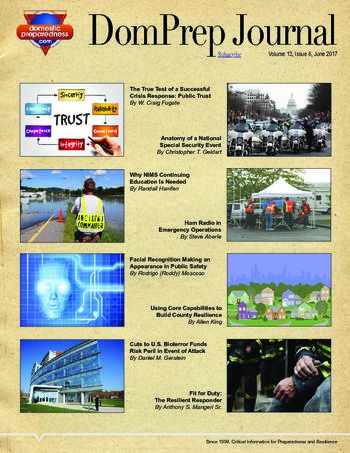

Fit for Duty: The Resilient Responder
Anthony S. Mangeri
June 28, 2017
The term “fit for duty” in modern firefighting goes beyond being physically fit to include being resilient to the stress and emotional effects of the job. For individual resilience, this means having the ability to prepare for and recover from stressful events so the responder can return to duty with some sense of normality. To accomplish this, responders must sleep well, eat right, and positively engage with peers.

Success or Failure of a Response: There Are Options
Catherine L. Feinman
June 28, 2017
The success or failure of an emergency response depends on many factors: planning, capabilities,
training, tools, funding, public trust, and the list goes on. This edition of the DomPrep Journal
examines potential points of failure as well as formulas for success when responding to a crisis.

Facial Recognition Making an Appearance in Public Safety
Rodrigo (Roddy) Moscoso
June 27, 2017
The use of facial recognition (FR) technologies to support public safety has long been considered a potent tool for law enforcement. The capability to automatically identify persons of interest in real-time has the potential to alert police of threats before an incident occurs. Long considered a technology of science fiction, FR is finally moving into the public safety mainstream with new capabilities now being rolled out.

The True Test of a Successful Crisis Response: Public Trust
The Honorable Craig Fugate
June 27, 2017
No organization, or government, can solve every problem. There will always be a crisis that will require an emergency response. And fundamental to the success of that response will be the public’s reaction. Emergency managers can react and can mobilize, but they will not be successful unless they do so in such a way as to ensure the public trust. This was apparent in 2005 with Hurricane Katrina, which was a crisis of government.

Ham Radio in Emergency Operations
Steve Aberle
June 21, 2017
Many people grew up hearing about disasters in far-off lands and how amateur (ham) radio operators were initially the only means of contact with the outside world. Disasters, both near and far, still occur today, and ham radio operators continue to volunteer their skills and personal radio equipment to serve the public. From a planning and operations perspective, emergency management professionals must effectively include these volunteer resources into comprehensive emergency management plans (CEMPs).

Cuts to U.S. Bioterror Funds Risk Peril in Event of Attack
Daniel M. Gerstein
June 21, 2017
President Donald Trump’s proposed fiscal year 2018 budget would eliminate a Department of Homeland
Security laboratory dedicated to countering bioterrorism and providing the science behind response and
recovery efforts should an attack occur. The proposal to eliminate this lab without creating replacement
capabilities elsewhere could place the U.S. at risk at a time when biotechnology proliferation is
increasing access to the knowledge and capabilities for developing bioterror weapons.

Using Core Capabilities to Build County Resilience
Allen B. King III
June 14, 2017
The lack of core capability guidance diminishes counties’ levels of preparedness and resilience and is a barrier to increasing these efforts for the nation as a whole. By using community associations as force multipliers, counties can leverage this valuable resource to increase resilience-building efforts beginning at the local level. This bottom-up approach builds not only physical but social resilience at all levels.

Why NIMS Continuing Education Is Needed
Randall W. Hanifen
June 14, 2017
The National Incident Management System (NIMS) and the National Response Framework are very important and overall well-constructed documents despite some past failures related to their implementation. However, one common denominator in disaster failures or successes is the people involved and the education and training of those personnel. Although federal mandates provide requirements for an initial certification, to date, no required refresher training exists. This article analyzes reasons that the NIMS Incident Command System (ICS) annual recertification should be required to maintain NIMS compliance.

Anatomy of a National Special Security Event
Christopher T. Geldart
June 7, 2017
There have been 56 National Special Security Events (NSSEs) since Presidential Directive 62
designated the category in 1998, 32 of which have been hosted in Washington, D.C. The most recent NSSEs
have been the 2017 Inauguration, the 2017 President’s Address to the Joint Session of Congress, and the
2015 World Meeting of Families, which involved a visit to the District by Pope Francis. Local
jurisdictions hosting such events must evaluate and plan for both the opportunities and challenges they
may face.

More Threats, More Interdependence, More Collaboration
Catherine L. Feinman
June 2, 2017
All disasters may begin locally, but their effects and resource needs can span jurisdictions and
can even have national implications. This edition of the DomPrep Journal examines ways to protect
critical infrastructure and communities from widespread catastrophe.

